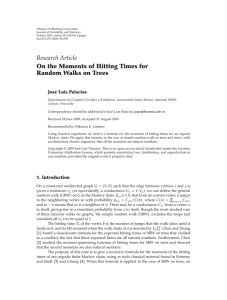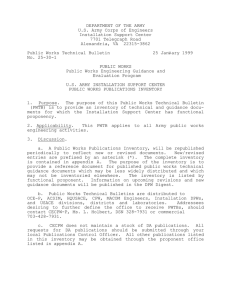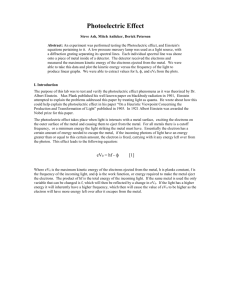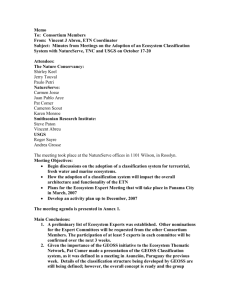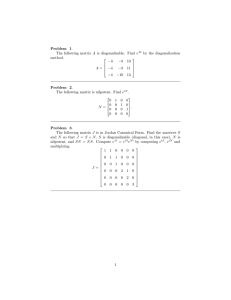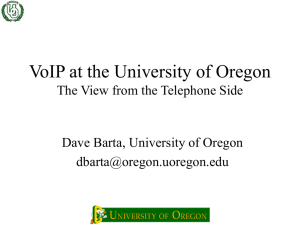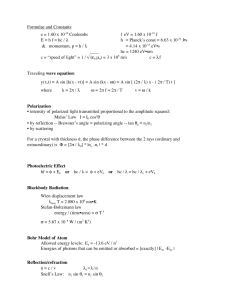Lecture 17 Discrete Time Theorem and Control Canonical Form 1 Discrete Time Theorem
advertisement
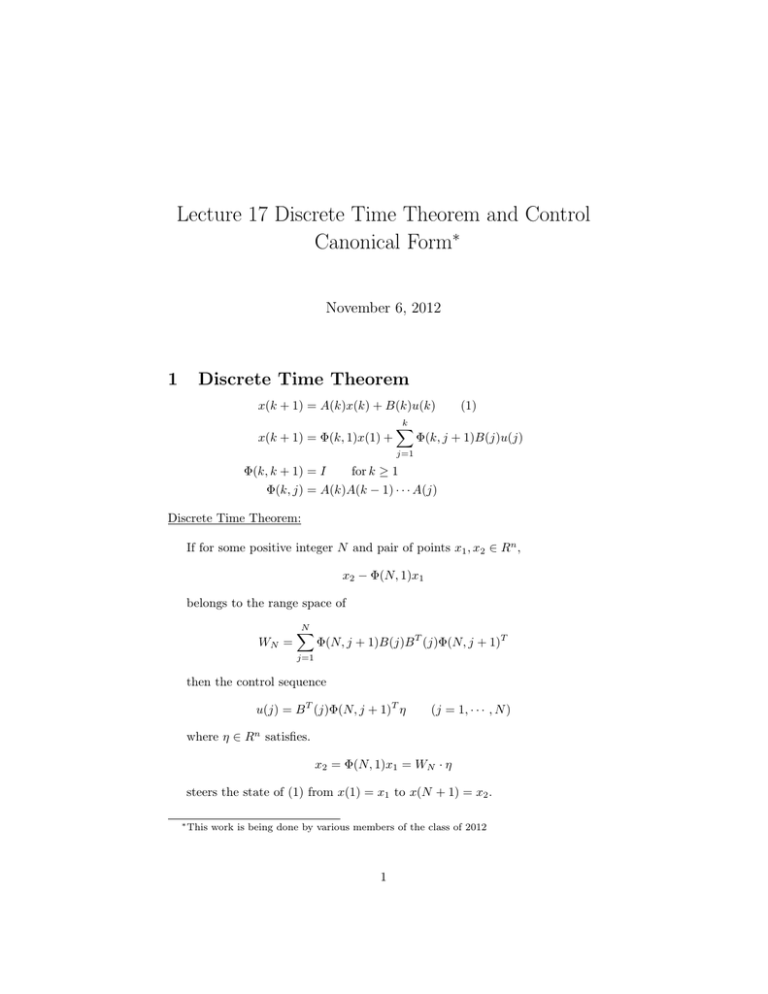
Lecture 17 Discrete Time Theorem and Control Canonical Form∗ November 6, 2012 1 Discrete Time Theorem x(k + 1) = A(k)x(k) + B(k)u(k) x(k + 1) = Φ(k, 1)x(1) + k X (1) Φ(k, j + 1)B(j)u(j) j=1 for k ≥ 1 Φ(k, k + 1) = I Φ(k, j) = A(k)A(k − 1) · · · A(j) Discrete Time Theorem: If for some positive integer N and pair of points x1 , x2 ∈ Rn , x2 − Φ(N, 1)x1 belongs to the range space of WN = N X Φ(N, j + 1)B(j)B T (j)Φ(N, j + 1)T j=1 then the control sequence u(j) = B T (j)Φ(N, j + 1)T η (j = 1, · · · , N ) where η ∈ Rn satisfies. x2 = Φ(N, 1)x1 = WN · η steers the state of (1) from x(1) = x1 to x(N + 1) = x2 . ∗ This work is being done by various members of the class of 2012 1 Control System Theory 2 Definition: The discrete time system (1) is said to be controllable if for any x1 , x2 ∈ Rn , there exists a positive integer N and an input sequence u(1), u(2), · · · , u(N ), such that N X x2 = Φ(N, 1)x1 + Φ(N, j + 1)B(j)u(j) j=1 Theorem: A constant coefficient (i.e. time invariant) discrete time system with scalar input x(k + 1) = Ax(k) + bu(k) A ∈ Rn×n b ∈ Rn×1 is controllable ⇔ rank (b, Ab, · · · , An−1 b) = n. Corollary: For the time invariant system x(k + 1) = Ax(k) + Bu(k) in which B is n × m with m ≥ 2, the condition rank (B, AB, · · · , An−1 B) = n is sufficient but not necessary for controllability. ẋ = Ax + Bu x(k + 1) = eA x(k) + Z 1 eA(1−s) Bds u(k) 0 This is the sampled system at unit intervals. Example: A= 0 −π π 0 B= 0 1 eA = −1 0 0 =Φ −1 Control System Theory 3 1 Z eA(t−s) Bds Z 1 cosπ(1 − s) sinπ(1 − s) 0 ds = −sinπ(1 − s) cosπ(1 − s) 1 02 = π 0 Γ= 0 3 (Γ, ΦΓ) = π 0 − π2 0 → rank=1. This system is not controllable. Invertibility: ẋ = Ax + Bu (2) y = Cx + Du This system is observable ⇔ rank C CA .. . CAn−1 =n Definition: The control system (2) is said to be invertible if wherever there are two input/output pairs (y1 , u1 ), (y2 , u2 ) such that y1 ≡ y2 , then u1 ≡ u2 . Theorem: The control system ẋ = Ax + bu y = Cx + du is convertible ⇐⇒ d cb cAb .. . rank cAn−2 b 0 d cb ··· ··· 0 0 0 ≥n .. . ··· ··· d 0 0 d ··· ··· ··· .. . Control System Theory 4 (As usual, the use of linear case b, c means that we are considering single input-single output [SISO] system) Given ẋ = Ax + bu (s) y = cx + du where does there exist a system ż = F z + gy (I) u = hz + ky such that the control u(·) which produces a given y(·) from (s) is generated by the output of Idea d 0 y(0) cb d y 0 (0) 00 cAb cb y (0) = .. .. . .. . . cAn−2 b · · · (I)? 0 0 d ··· 0 u(0) 0 u̇(0) 0 ü(0) .. .. . . ··· d ··· ··· ··· .. . In order to have invertibility and to realize the system (I), we probably read k= 1 d and we may further conjecture that c h=− , d g= b , d F =A− bc d Theorem: Given (s), we find (I) given by the above values, and the frequency domain statement of invertibility is c(Is − A)−1 b + d h(Is − F ) −1 g+k (s) (I) Control System Theory 5 where the system has the inverse 2 Canonical forms and realizations ẋ = Ax + bu The system is controllable ⇔ M = (b, Ab, · · · , An−1 b) is invertible. Suppose this is the case T T e1 b e1 eT2 b M −1 M = . M −1 = ... .. eTn 0 we claim that Proof: eTn , eTn A, eTn An−1 eT1 Ab · · · eT2 Ab · · · .. . 0 eT1 An−1 b eT2 An−1 b .. . ··· 1 are linearly independant. Suppose α1 eTn + α2 eTn A + · · · + α2 eTn An−1 = 0 Multiply both sides of this equation on the right by b, α1 eTn b + α2 eTn Ab + · · · + α2 eTn An−1 b = 0 Hence we have α1 eTn + α2 eTn A + · · · + α2 eTn An−2 = 0 Multiply on the right side by Ab as before, this implies αn−1 = 0. Continuing this way, we establish our claim. Control System Theory 6 Let eTn eTn A .. . P = eTn An−1 By our calculation, P is invertible. Let z(t) = P x(t), then ż = P AP −1 z(t) + P bu(t). Note that eTn b eTn Ab .. . 0 0 Pb = = .. . T n−1 1 b en A . . To see what P AP −1 is, denote P −1 = (P1 .. · · · ..Pn ) Then, 1 T k en A Pj −aj−1 0 if k = j − 1 if k = n otherwise Hence, eTn eTn A .. . . . P AP −1 = A(P1 .. · · · ..Pn ) eTn An−1 0 1 0 ··· 0 0 0 1 0 Ā = . .. .. .. . 1 . −a0 −a1 · · · · · · −an−1 det(Ā − λI) = (−1)n a0 + (−1)n a1 λ + · · · + (−1)n an−1 λn−1 + (−1)n λn The a0j s in the bottom row are the coefficients of the characteristic polynomial.(called companion form) The pair Ā = 0 0 .. . 1 0 .. . 0 1 .. . ··· −a0 −a1 ··· ··· 0 0 1 −an − 1 0 .. b̄ = . 0 1 Control System Theory Is said to be control canonical form. 7
